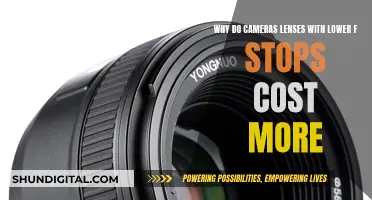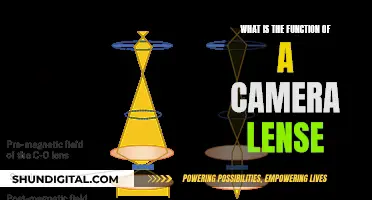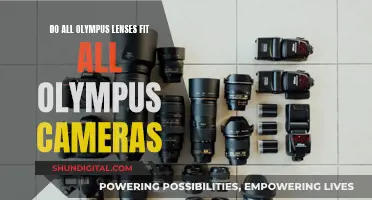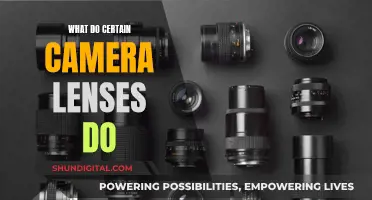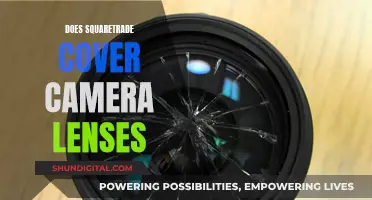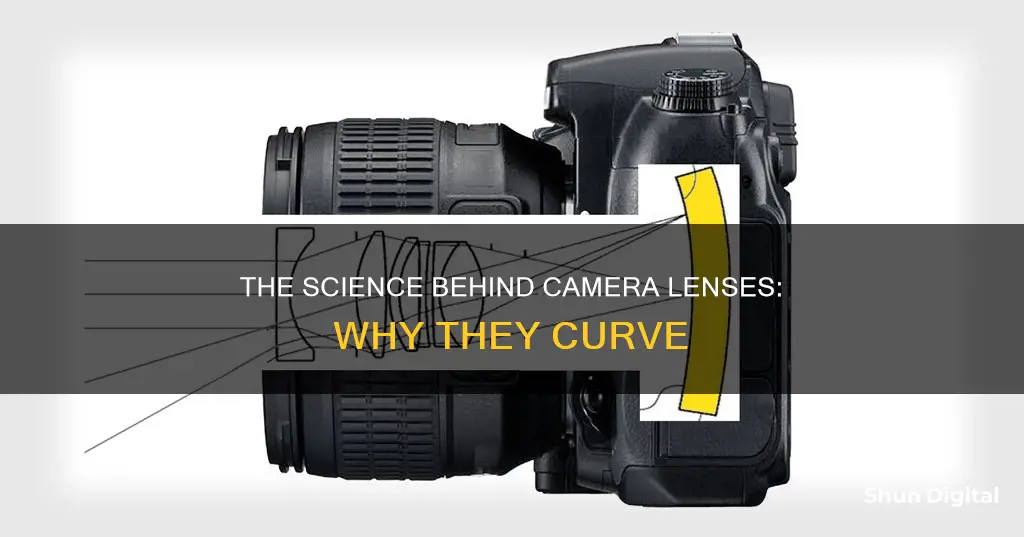
Camera lenses are curved to capture a wide field of view. The curved shape of the lens allows it to capture a wide view of the scene, but as a result, objects at the edge of the image are a different distance from the lens than those at the center. This creates a barrel distortion effect, where straight lines appear to curve at the edges of the image, and objects at the edge of the frame aren't as enlarged as those in the center. This effect is more prominent in wide-angle lenses, which have a more spherical shape than telephoto lenses.
What You'll Learn

To capture a wide field of view
Camera lenses are curved to capture a wide field of view. The curve of the lens allows it to capture a wide view of the scene. This is especially true for wide-angle lenses, which have much more spherical glass than a telephoto lens.
The more extreme the curve of the lens, the wider the field of view it can capture. This is why wide-angle lenses often exhibit what is known as "barrel distortion". Barrel distortion occurs when straight lines bend outward from the centre of the image, creating a circular, barrel-like shape. This is due to the difference in distance from the lens between objects at the edge of the image and those at the centre. Objects at the edge of the frame are not enlarged as much as those in the centre.
The opposite problem, known as "pincushion distortion", occurs with telephoto lenses. In this case, the magnification is greatest at the centre, causing the edges of the photo to appear bent inwards.
While lens distortion can be undesirable in some cases, it can also be used creatively to achieve certain effects. For example, it can be used to make a photograph more dynamic or to portray humour or a particular feeling.
Large Camera Lenses: Capturing the Bigger Picture
You may want to see also

To avoid a fisheye effect
Camera lenses are curved to capture a wide field of view. This curvature, however, can cause a fisheye effect, where images appear distorted, with straight lines appearing curved. This is known as barrel distortion.
To avoid the fisheye effect, you can:
- Adjust your position: Move higher, lower, to the side, or change the plane of your camera in relation to your subject.
- Adjust your distance: Stand further away from your subject, especially if using a wide-angle lens.
- Adjust your focal length: Choose a standard focal length like 50mm to minimise barrel distortion.
- Use a different lens: Telephoto lenses have the opposite problem, known as pincushion distortion, where the edges of the photo appear to bend inwards.
- Correct in post-processing: Use software like Adobe Lightroom or Photoshop to reverse the distortion.
The High Cost of Mirrorless Camera Lenses: Why?
You may want to see also

To reduce field curvature
Field curvature, also known as "curvature of field" or "Petzval field curvature", is a common optical problem that causes a flat object to appear sharp only in a certain part of the frame, instead of being uniformly sharp across the frame. This happens due to the curved nature of optical elements, which project the image in a curved manner, rather than flat.
The best way to reduce field curvature is to stop down the lens. If a lens has a small to moderate amount of field curvature, stopping down a little will significantly reduce it. But if a lens suffers from heavy field curvature, then stopping down to f/8 or f/11 may be necessary to reduce it. In some cases, even stopping down to the smallest aperture may not fully eliminate the issue.
In addition to stopping down the lens, using a longer focal length can also help to reduce field curvature. Short-range lenses (ultra-wide, wide, and normal) below 50mm typically suffer from curvature problems the most, whereas telephoto lenses often have very little or no visible field curvature.
It is also worth noting that field curvature behaviour can vary by distance. Some lenses may exhibit strong field curvature at infinity but show no visible curvature at short ranges.
While it is not possible to fix field curvature in post-processing software, understanding how it works can help photographers make informed decisions when capturing images to minimise its impact.
Understanding Camera Lenses: Millimeter Measurements Explained
You may want to see also

To avoid barrel distortion
Camera lenses are curved to avoid barrel distortion, among other reasons. Barrel distortion is a common issue in photography, particularly when using a wide-angle lens. It occurs when the magnification of an image decreases the further the object is from the optical axis of the lens, causing the edges of the photo to appear curved and bowed. This effect is most noticeable when photographing subjects with straight lines, such as buildings or landscapes, and can result in images that appear distorted.
In addition to these in-camera techniques, barrel distortion can also be corrected in post-processing using software tools. Adobe Lightroom, Photoshop, and other image editing software offer lens correction tools that can automatically correct distortion based on the lens profile. These tools can also be used manually to fine-tune the correction if needed. However, it is important to consider the impact of lens correction on the overall composition of the image, as correcting distortion may result in a loss of image area and require cropping.
The Science Behind Camera Lenses' White Color
You may want to see also

To reduce chromatic aberration
Camera lenses are curved to reduce chromatic aberration, a type of optical distortion that is most obvious in the high-contrast areas of a photo. Chromatic aberration appears as coloured fringing along the edges of objects, often purple or green. This type of aberration occurs because the lens has a curved shape, which causes the centre of the photo to be magnified more than the edges. As a result, straight lines appear to curve outwards at the edges of the image, an effect known as barrel distortion.
Additionally, the use of high-end lenses can help minimise chromatic aberration. More expensive lenses typically exhibit less distortion than cheaper options due to their superior optical design and construction. Lenses with multiple optical elements can also help combat chromatic aberration. These lenses incorporate specific elements strategically placed to reduce the effect of field curvature, resulting in sharper images with less distortion.
Post-processing software can also be utilised to correct chromatic aberration. Programs like Adobe Lightroom and Photoshop offer lens correction tools that can reduce or eliminate this type of distortion. By using the lens profile and metadata stored within the photo, these software applications can reverse the optical distortions created by the lens.
While it is challenging to completely eliminate chromatic aberration, understanding its causes and employing a combination of in-camera techniques and post-processing corrections can effectively minimise its impact on photographs.
Veronica Mars' Camera Lens: Uncovering the Mystery
You may want to see also
Frequently asked questions
Camera lenses curve to capture a wide field of view. The curved shape of the lens allows it to capture a wide view of the scene, but it also means that objects at the edge of the image are a different distance from the lens than those at the center.
The curved shape of the lens causes objects at the edge of the frame to appear less enlarged than objects in the center. This results in a type of distortion called "barrel distortion," where straight lines curve outward at the edges of the image, creating a circular, barrel-like shape.
Field curvature, also known as "curvature of field," is an optical problem that causes a flat object to appear sharp only in certain parts of the frame, rather than uniformly sharp across the entire frame. This occurs due to the curved nature of the lens, which projects the image in a curved manner. As a result, digital camera sensors, which are flat, cannot capture the entire image in perfect focus.
Lens curvature can create unpredictable results and make it challenging to work with autofocus systems. It can also affect depth of field calculations and infinity performance. However, it can be used creatively to achieve unique rendering effects and separate objects from their backgrounds.


